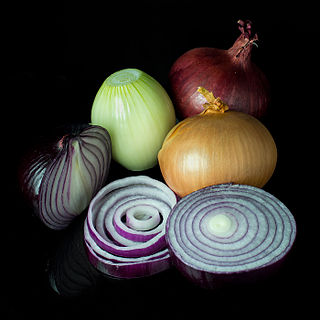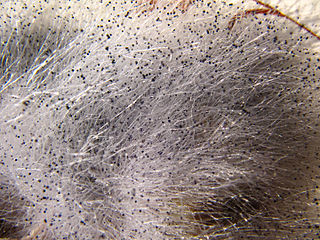
Slime mold or slime mould is an informal name given to a polyphyletic assemblage of unrelated eukaryotic organisms in the Stramenopiles, Rhizaria, Discoba, Amoebozoa and Holomycota clades. Most are microscopic; those in the Myxogastria form larger plasmodial slime molds visible to the naked eye. The slime mold life cycle includes a free-living single-celled stage and the formation of spores. Spores are often produced in macroscopic multicellular or multinucleate fruiting bodies that may be formed through aggregation or fusion; aggregation is driven by chemical signals called acrasins. Slime molds contribute to the decomposition of dead vegetation; some are parasitic.

Mold health issues refer to the harmful health effects of molds and their mycotoxins. However, recent research has shown these adverse health effects are caused not exclusively by molds, but also other microbial agents and biotoxins associated with dampness, mold, and water-damaged buildings, such as gram-negative bacteria that produce endotoxins, as well as actinomycetes and their associated exotoxins. Approximately 47% of houses in the United States have substantial levels of mold, with over 85% of commercial and office buildings found to have water damage predictive of mold. As many as 21% of asthma cases may result from exposure to mold. Substantial and statistically significant increases in the risks of both respiratory infections and bronchitis have been associated with dampness in homes and the resulting mold.

Hay is grass, legumes, or other herbaceous plants that have been cut and dried to be stored for use as animal fodder, either for large grazing animals raised as livestock, such as cattle, horses, goats, and sheep, or for smaller domesticated animals such as rabbits and guinea pigs. Pigs can eat hay, but do not digest it as efficiently as herbivores do.

An onion, also known as the bulb onion or common onion, is a vegetable that is the most widely cultivated species of the genus Allium. The shallot is a botanical variety of the onion which was classified as a separate species until 2011. Its close relatives include garlic, scallion, leek, and chive.

A mold or mould is one of the structures that certain fungi can form. The dust-like, colored appearance of molds is due to the formation of spores containing fungal secondary metabolites. The spores are the dispersal units of the fungi. Not all fungi form molds. Some fungi form mushrooms; others grow as single cells and are called microfungi.

The peanut, also known as the groundnut, goober (US), goober pea, pindar (US) or monkey nut (UK), is a legume crop grown mainly for its edible seeds. It is widely grown in the tropics and subtropics by small and large commercial producers, both as grain legume and as an oil crop. Atypically among legumes, peanut pods develop underground leading botanist Carl Linnaeus to name peanuts hypogaea, which means "under the earth".

Botrytis cinerea is a necrotrophic fungus that affects many plant species, although its most notable hosts may be wine grapes. In viticulture, it is commonly known as "botrytis bunch rot"; in horticulture, it is usually called "grey mould" or "gray mold".

Tempeh or tempe is a traditional Indonesian food made from fermented soybeans. It is made by a natural culturing and controlled fermentation process that binds soybeans into a cake form. A fungus, Rhizopus oligosporus or Rhizopus oryzae, is used in the fermentation process and is also known as tempeh starter.

Aspergillus niger is a mold classified within the Nigri section of the Aspergillus genus. The Aspergillus genus consists of common molds found throughout the environment within soil and water, on vegetation, in fecal matter, on decomposing matter, and suspended in the air. Species within this genus often grow quickly and can sporulate within a few days of germination. A combination of characteristics unique to A. niger makes the microbe invaluable to the production of many acids, proteins and bioactive compounds. Characteristics including extensive metabolic diversity, high production yield, secretion capability, and the ability to conduct post-translational modifications are responsible for A. niger's robust production of secondary metabolites. A. niger's capability to withstand extremely acidic conditions makes it especially important to the industrial production of citric acid.

Mycoprotein, also known as mycelium-based protein or fungal protein, is a form of single-cell protein derived from fungi for human consumption.

Athlete's foot, known medically as tinea pedis, is a common skin infection of the feet caused by a fungus. Signs and symptoms often include itching, scaling, cracking and redness. In rare cases the skin may blister. Athlete's foot fungus may infect any part of the foot, but most often grows between the toes. The next most common area is the bottom of the foot. The same fungus may also affect the nails or the hands. It is a member of the group of diseases known as tinea.

Dry rot is wood decay caused by one of several species of fungi that digest parts of wood which give it strength and stiffness. It was previously used to describe any decay of cured wood in ships and buildings by a fungus which resulted in a darkly colored deteriorated and cracked condition.

Amaranthus caudatus is a species of annual flowering plant. It goes by common names such as love-lies-bleeding, pendant amaranth, tassel flower, velvet flower, foxtail amaranth, and quelite.

Damping off is a horticultural disease or condition, caused by several different pathogens that kill or weaken seeds or seedlings before or after they germinate. It is most prevalent in wet and cool conditions.

Penicillium expansum is a psychrophilic blue mold that is common throughout the world in soil. It causes Blue Mold of apples, one of the most prevalent and economically damaging post-harvest diseases of apples.

Sclerotinia sclerotiorum is a plant pathogenic fungus and can cause a disease called white mold if conditions are conducive. S. sclerotiorum can also be known as cottony rot, watery soft rot, stem rot, drop, crown rot and blossom blight. A key characteristic of this pathogen is its ability to produce black resting structures known as sclerotia and white fuzzy growths of mycelium on the plant it infects. These sclerotia give rise to a fruiting body in the spring that produces spores in a sac which is why fungi in this class are called sac fungi (Ascomycota). This pathogen can occur on many continents and has a wide host range of plants. When S. sclerotiorum is onset in the field by favorable environmental conditions, losses can be great and control measures should be considered.

Choanephora cucurbitarum is a fungal plant pathogen that causes fruit and blossom rot of various cucurbits. It can also affect okra, snap bean, and southern pea, and may cause a stem and leaf rot of Withania somnifera. Recently Das et al. 2017 added few more patho-index on aubergine, teasle gourd (Momordica subangulata Blume subsp. renigera de Wilde, hyacinth bean, green pea from India. Wet weather, high temperature and high humidity favor disease development from inoculum that is typically soil-borne. Signs of infection on fruits or leaves include water-soaked, necrotic lesions, which progress rapidly under ideal conditions. As the fungus begins to produce spores, affected tissues become dark grey-brown and hairy as a result of the superficial sporangia.

Indoor mold or indoor mould, also sometimes referred to as mildew, is a fungal growth that develops on wet materials in interior spaces. Mold is a natural part of the environment and plays an important part in nature by breaking down dead organic matter such as fallen leaves and dead trees; indoors, mold growth should be avoided. Mold reproduces by means of tiny spores. The spores are like seeds, but invisible to the naked eye, that float through the air and deposit on surfaces. When the temperature, moisture, and available nutrient conditions are correct, the spores can form into new mold colonies where they are deposited. There are many types of mold, but all require moisture and a food source for growth.

Coniophora is a genus of fungi within the order Boletales. Basidiocarps are corticioid (patch-forming). There are 20 species in the genus, which has a widespread distribution. One notable member is the cellar fungus (C. puteana), which causes wet rot in wood. Molecular analysis has revealed that there are cryptic species in the fungal lineages Coniophora olivacea, C. arida, and C. puteana.

Rhizopus stolonifer is commonly known as black bread mold. It is a member of Zygomycota and considered the most important species in the genus Rhizopus. It is one of the most common fungi in the world and has a global distribution although it is most commonly found in tropical and subtropical regions. It is a common agent of decomposition of stored foods. Like other members of the genus Rhizopus, R. stolonifer grows rapidly, mostly in indoor environments.




















